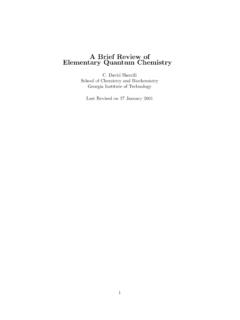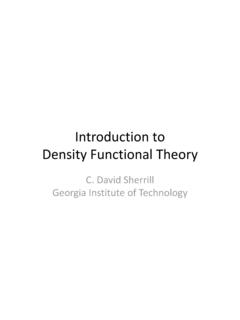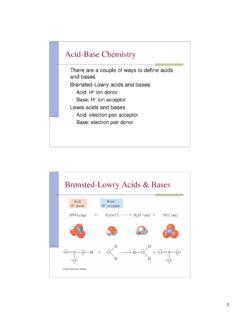Transcription of Basis Sets in Quantum Chemistry C. David Sherrill
1 Basis Sets in Quantum Chemistry C. David Sherrill School of Chemistry and Biochemistry Georgia Institute of Technology Basis Sets Generically, a Basis set is a collection of vectors which spans (defines) a space in which a problem is solved i, j, k define a Cartesian, 3D linear vector space In Quantum Chemistry , the Basis set usually refers to the set of (nonorthogonal) one-particle functions used to build molecular orbitals Sometimes, theorists might also refer to N -electron Basis sets, which is something else entirely sets of Slater determinants Basis Sets in Quantum Chemistry LCAO-MO approximation: MO's built from AO's An orbital is a one-electron function AO's represented by atom-centered Gaussians in most Quantum Chemistry programs why Gaussians? (GTO's). Some older programs used Slater functions (STO's). Physicists like plane wave Basis sets Slater-Type Orbitals (STO's). ST O a b c r abc (x, y, z) = N x y z e N is a normalization constant a, b, c control angular momentum, L = a + b + c (zeta) controls the width of the orbital (large gives tight function, small gives diffuse function).
2 These are H-atom-like, at least for 1s; however, they lack radial nodes and are not pure spherical harmonics (how to get 2s or 2p, then?). Correct short-range and long-range behavior Gaussian-Type Orbitals (GTO's). a b c r 2. GT O. abc (x, y, z) = Nx y z e Again, a, b, c control angular momentum, L = a + b + c Again, controls width of orbital No longer H-atom-like, even for 1s Much easier to compute (Gaussian product theorem). Almost universally used by Quantum chemists Contracted Gaussian-Type Orbitals (CGTO's). Problem: STO's are more accurate, but it takes longer to compute integrals using them Solution: Use a linear combination of enough GTO's to mimic an STO. Unfortunate: A combination of n Gaussians to mimic an STO is often called an STO-nG Basis , even though it is made of CGTO' X. n a b c i r 2. CGT. abc O. (x, y, z) =N ci x y z e (1). i=1. Figure from Szabo and Ostlund, Modern Quantum Chemistry . Types of Basis Sets Minimal: One Basis function (STO, GTO, or CGTO) for each atomic orbital in the atom Double-zeta: Two Basis functions for each AO.
3 Triple-zeta: Three Basis functions for each AO.. and etc. for quadruple-zeta (QZ), 5Z, 6Z, .. Having different-sized functions allows the orbital to get bigger or smaller when other atoms approach it A split-valence Basis uses only one Basis function for each core AO, and a larger Basis for the valence AO's Examples H atom, minimal Basis : One 1s AO, one (STO, GTO, or CGTO) Basis function C atom, minimal Basis : 1s, 2s, 2px , 2py , 2pz AO's (5), so 5. Basis functions C atom, double-zeta Basis : Two Basis functions per AO, so 10 Basis functions C atom, split-valence double-zeta Basis : 9 Basis func- tions (why?). Counting Basis Functions Note: When counting Basis functions with a Basis set that includes CGTO's, each CGTO counts as a single Basis function. We do not count the primitive GTO functions inside a CGTO. as Basis functions.. For example, in a 6-31G* Basis , carbon has one Basis function . representing the 1s atomic orbital, not six.
4 Polarization Functions As other atoms approach, an atom's orbitals might want to shift to one side or the other (polarization). An s orbital can polarize in one direction if it's mixed with a p orbital. p orbitals can polarize if mixed with d orbitals In general, to polarize a Basis function with angular momentum l, mix it with Basis functions of angular momentum l + 1. This gives polarized double-zeta , or double-zeta plus polarization Basis sets, etc Counting Polarization Functions We know there should be 5 d functions (usually chosen as dx2 y2 , dz2 , dxy , dxz , and dyz ); these are called pure angular momentum functions (even though they aren't, really). Computers would prefer to work with 6 d functions (dx2 , dy2 , dz2 , dxy , dxz , and dyz ); these are called 6 Cartesian d functions . dx2 + dy2 + dz2 looks like an s orbital Similar answers are obtained using 5 or 6 d functions For f functions, it's 7 versus 10 f functions Common reason for disagreement between calculated results and literature values different number of polar- ization functions Some Basis sets were developed using 5d's [cc-pVXZ, newer Pople Basis sets like 6-311G(3df)], some using 6 d's [older Pople Basis sets like 6-31G(d)]; results don't change much, but it is more consistent to use the same number of polarization functions as the Basis set designer Different programs have different default values for number of polarization functions can make it hard to compare across programs if you don't notice it Diffuse Functions Diffuse functions have small exponents.
5 This means the electron is held far away from the nucleus Necessary for anions, Rydberg states, very electronegative atoms (fluorine) with a lot of electron density Necessary for accurate polarizabilities or binding energies of van der Waals complexes (bound by dispersion). It is very bad to do computations on anions without using diffuse functions; your results could change completely! Anatomy of a Basis Set: H atom, STO-3G. A Basis set of Contracted Gaussian-Type Orbitals (CGTO's). needs to specify the exponents ( i 's) and the contraction coefficients (ci 's). These are given below in the format used by the Gaussian program (exponents first). H 0. S 3 **. Anatomy of a Basis Set: C atom, STO-3G. C 0. S 3 SP 3 **. STO-3G and other Basis sets by John Pople use SP shells, which share exponents for s and p functions Pople Basis Sets Developed by the late Nobel Laureate, John Pople, and popularized by the Gaussian set of programs STO-3G is a minimal Basis set in which each AO is represented by 3 Gaussians (3G), chosen to mimic the behavior of a STO.
6 Pople's split-valence double-zeta Basis set is called 6-31G;. the core orbital is a CGTO made of 6 Gaussians, and the valence is described by two orbitals one CGTO made of 3 Gaussians, and one single Gaussian Anatomy of a Basis Set: C atom, 6-31G. C 0. S 6 SP 3 SP 1 More on Pople Basis Sets 6-31G* [or 6-31G(d)] is 6-31G with added d polarization functions on non-hydrogen atoms; 6-31G** [or 6-31G(d,p)]. is 6-31G* plus p polarization functions for hydrogen 6-311G is a split-valence triple-zeta Basis ; it adds one GTO. to 6-31G. 6-31+G is 6-31G plus diffuse s and p functions for non- hydrogen atoms; 6-31++G has diffuse functions for hydro- gen also In a Basis like 6-311G(3df,2pd), we add 3 sets of d functions and one set of f functions to heavy atoms, and 2 sets of p functions and one set of d functions to hydrogen atoms Designations of Basis Set Size It is useful to refer to how large a Basis set is by listing how many sets of functions it has for each angular momentum type.
7 Examples: H atom, minimal Basis : 1s (1 function). C atom, minimal Basis : 2s1p (5 functions). C atom, double-zeta Basis : 4s2p (10 functions). C atom, split-valence double-zeta Basis : 3s2p (9 func- tions). Dunning's Correlation-Consistent Basis Sets Thom Dunning pointed out that Basis sets optimized at the Hartree-Fock level might not be ideal for correlated computations The correlation consistent Basis sets are optimized using correlated (CISD) wavefunctions cc-pVXZ means a Dunning correlation-consistent, polarized valence, X-zeta Basis ; X=D,T,Q,5,6,7. Functions are added in shells. cc-pVDZ for C atom consists of 3s2p1d. cc-pVTZ would be 4s3p2d1f. cc-pVQZ would be 5s4p3d2f1g. The Dunning Basis sets are designed to converge smoothly toward the complete (infinite) Basis set limit A prefix aug means one set of diffuse functions is added for every angular momentum present in the Basis ;. aug-cc-pVDZ for C atom has diffuse s,p,d Somewhat cheaper versions of aug-cc-pVXZ are the cal- endar Basis sets of Truhlar; pretending aug stands for August, Basis sets with truncated diffuse functions are represented by earlier months in the calendar.
8 Jul-cc-pVXZ. removes diffuse functions on H atoms. jun-cc-pVXZ re- moves diffuse functions on H atoms and also the highest angular momentum subshell from heavy atoms. Earlier months in the calendar (may-, etc.) remove the next- highest remaining angular momentum subshell of diffuse functions. Functions describing core correlation are denoted by the letter C in the cc-pCVXZ or aug-cc-pCVXZ Basis sets;. you should use Basis sets like this if you do not freeze core electrons in post-Hartree-Fock computations like MP2, CISD, CCSD(T), etc. For 2nd row elements Al-Ar, the original d polarization functions were not tight enough; revised in cc-pV(X+d)Z. Basis sets Convergence of Vibrational Frequencies for BH, CH+ , and NH. Figure 1. Convergence of CCSD(T) re and e toward the CBS limit derived for valence-only (cc-pVNZ) Basis sets. Temelso, Valeev, and Sherrill , J. Phys. Chem. A 108, 3068 (2004). Convergence of Bond Lengths for BH, CH+ , and NH.
9 Temelso, Valeev, and Sherrill , J. Phys. Chem. A 108, 3068 (2004). 6434 Helgaker et al.: Molecular equilibrium structures FIG. 3. Normal distributions r(R) for the errors in the calculated bond distances. The distributions have been calculated from the mean errors in Table III and the standard deviations in Table IV ~pm!. For easy comparison, all distributions have been normalized to one and plotted on the same horizontal and vertical scales. Helgaker et al, J. Chem. Phys. 106, 6430 (1997). General Comments The bigger the Basis , the better? Usually need to balance with correlation method; , cc-pVQZ is great for CCSD(T), but overkill for Hartree-Fock STO-3G should not be used: too small Hard to afford more than polarized double-zeta Basis sets except for small molecules Anions must have diffuse functions In our experience, cc-pVDZ is not necessarily better than 6-31G(d,p); however, cc-pVTZ is better than 6-311G(d,p).
10 Or similar Convergence of ab initio results is disappointingly slow with respect to Basis set for non-DFT methods (see, for example, papers by Helgaker or Dunning). DFT is less dependent on Basis set size than wavefunction- based methods (see, for example, papers by Angela Wilson). Best resource for getting Basis sets: I couldn't mention all the important Basis sets others are out there!
















